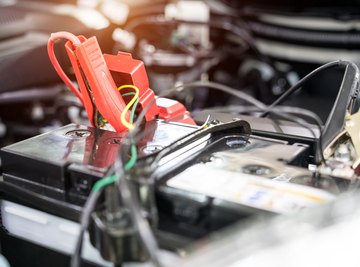
Recharging batteries can prove handy for long-term projects and saving energy. The process of charging batteries using a device like a charger means creating an electrical circuit to increase the charge stored in the individual batteries. You can figure out more about these circuits so you, too, can learn the best ways to charge batteries when using a charger.
These tutorials and explanations of how to charge batteries in line with one another mean you're going to be building electrical circuits that can take advantage of how chargers work to appropriately charge batteries.
Be careful when working with circuits as you shouldn't touch the ends of wire unless they're insulated to protect themselves and avoid touching the circuit if the wires or batteries are wet. Don't mix sizes of batteries that have different voltages or amp-hour (AH) capacities, and use rubber gloves if needed to insulate your hands from electricity and protect yourself.
Series circuits send current in a single direction around a loop while parallel circuits send current in different paths across branches. Series and parallel methods means that charging 12 volt (12 V) batteries in line can use either a series or a parallel circuit. In series circuits, the current is constant throughout the circuit and the voltage changes across each element of the circuit.
In parallel circuits, the voltage drop through each branch of the circuit is the same while the current changes throughout the circuit.
Charging Batteries in Series
When charging 3 12V batteries in series with one another, each voltage of each battery would increase in an amount dictated by Ohm's Law
for voltage V (in volts), current I (in amperes) and resistance R (in ohms). This makes charging the battery difficult because the increases in voltage will provide different charges to each battery.
You can use a charger for the batteries themselves that uses the increased voltage output more effectively, but connecting batteries in series doesn't affect the AH capacity of the circuit, a measurement of how much energy the battery can store. This means you should focus on the increased voltage and ways to use that to charge multiple 12 V batteries by using, for example, a charger with the same voltage as each battery.
One basic configuration for charging batteries in series is to connect the positive charger output (in red) to the positive end of one of the batteries. Then, connect the negative end of the battery to the positive end of the next one, and continue to do so for the rest of your batteries.
For the final battery, connect the negative end of the battery to the negative output (in black) of the charger. If you have two chargers, you can instead connect both positive and negative charger outputs for the first charger to the first battery and connect both positive and negative charger outputs for the second charger to the final battery.
In the case of using two or more chargers, you can find the total voltage of the battery source by summing up each charger. If you can find a charger for each battery, that can ensure each battery will be charged to its full capacity. Using more chargers can be more ideal as it makes sure each battery will be charged simultaneously, but it depends on your needs. For charging 6 volt batteries in series with a 12 volt charger, you can use a single charger.
Knowing the difference between series and parallel circuits to charge batteries can help you improve the efficiency of your batteries through different methods as a result of the varying physics between series and parallel circuits. While charging batteries in series can restore charge to them by increasing the voltage across each of them, charging batteries in parallel functions differently.
Charging Batteries in Parallel
When charging batteries in parallel, you aren't charging the voltage of the batteries, but, rather, the amp-hour capacity of the batteries. The AH capacity, also known as AH specification or rating, tells you the product of current of the battery by how long the battery can produce that current. The AH value also changes based on how long the battery is used for. A "100 AH at 2 hr" rating tells you a battery can provide 5 amps of current for 20 hours. Calculate these values to determine how parallel circuit changes the AH capacity.
Keep in mind the corresponding lengths of time associated with each AH capacity. A battery that's marked as 100 AH won't provide 100 amps of current for one hour. It will probably only provide about 40 minutes of current at 100 amps. This is because lead acid batteries lose the capacity to let current flow as the rate of discharge increases as a result of Peukert's Law.
In parallel, batteries have an increased AH capacity even when voltage is the same across each battery. The parallel setup of the circuit can use its branches to increase how long a battery can power items at the AH capacity. If you want to set up a parallel charging circuit, the batteries will still only power up to their standard voltage. Charging batteries in a parallel circuit means you should consider how the AH capacity will increase.
An example method of charging batteries in parallel is to use one branch of the parallel circuit to charge each battery with a single charger. Connect the positive output of the charger to the positive terminal of the first battery, and connect that positive terminal to the positive terminal of the second battery. Continue this until all the batteries are connected. Then, connect the charger's negative output to the negative end of the first battery, and proceed to connect each negative end the same way you did for the positive ends.
Applications of These Methods
There are other ways of connecting circuits to charge batteries. While these examples have used pure series and pure parallel circuits, you can connect batteries using series-parallel circuit hybrids. These types of circuit use elements that create closed loops that you find in series circuits as well as branches to distribute current through different paths in parallel circuits.
One way to demonstrate a series-parallel circuit is to use four batteries with a single charger. Connect the positive output of the charger to the positive terminal of the first battery, and, then connect the battery's positive terminal to the positive terminal of the second battery.
Similarly, connect the negative output of the charger to the negative terminal of the third battery, and then connect the negative terminal of the third battery to the negative terminal of the fourth. Finally, connect the negative terminals of the first and second batteries to the positive terminals of the third and fourth batteries, respectively.
This setup creates series circuits between two of the batteries themselves while also connecting two of the batteries in parallel with each other. If you were to solve this circuit using equations of physics and math to describe current and voltage, you'd have to treat the series components as flowing in series with each other and the parallel components in parallel.
This configuration, known as a 2s2p for the series and parallel components, is actually used in four-cell energy cells by taking advantage of the increase voltage and AH capacity appropriately. These circuits are further regulated with integrated circuits, microscope circuit chips of resistors, capacitors, transistors and other elements on a semiconductor (material which can conduct electricity) that were invented to reduce the necessary components in a circuit down to a single chip.
Lithium ions in particular use a combination of cells in parallel and adding them in series to reduce the complexity of voltages and keep the cells at normal voltage values.
References
About the Author
S. Hussain Ather is a Master's student in Science Communications the University of California, Santa Cruz. After studying physics and philosophy as an undergraduate at Indiana University-Bloomington, he worked as a scientist at the National Institutes of Health for two years. He primarily performs research in and write about neuroscience and philosophy, however, his interests span ethics, policy, and other areas relevant to science.
